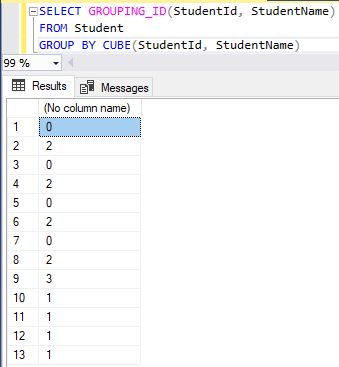

Then you need the solution using a window function (Solution 2). It's more complicated if you'd also like to display some other columns. You can rename the column using the AS keyword with a new name. You simply use the aggregate function (here: SUM) with the correct column and at the end of the query you group by year. If you don't feel comfortable with the concept of GROUP BY, take a look here where we explain it. If you'd like to display the year and the total money earned in this year, a simple GROUP BY is enough. In this example it's assumed that you already have the year column. SUM(money) OVER(PARTITION BY year) AS money_earned Solution 2 (displaying year, month, day and the money earned in the corresponding year): You would like to group all your data by this column and calculate the total money earned each year. You can read more about the window functions in this article. Note that you don't yet have the year column when calculating the sum, so PARTITION BY year won't work – you would get an error 'column "year" does not exist'. After SUM(money) you write the OVER() clause and, since you'd like to calculate the sum for each year, use PARTITION BY EXTRACT(year FROM transaction_date) inside it. If you'd like to display more columns, you need a window function (Solution 2). At the end of the query you need a GROUP BY EXTRACT(year FROM transaction_date) or, simpler, GROUP BY 1 (since EXTRACT(year FROM transaction_date) is the first column.) The second column is the aggregate function SUM(money). The first selected column is the year extracted from the date. If you'd like to display just the year and the total money earned in this year, you can use a GROUP BY.
#Aggregate date up to a date sql how to
If you want to learn more about the EXTRACT function and how to retrieve different parts from the date, you can find it here. It's a good idea to rename the column to year afterwards. The date is the column which contains the dates – the transaction_date column.

In your case, you'd like to extract the year, so the part is year. You can use the EXTRACT(part FROM date) function to do it.

Instead you have the column with complete dates.įirst, you need to retrieve a year from the date. In this example it's assumed that you don't have the year column. SUM(money) OVER(PARTITION BY EXTRACT(year FROM transaction_date)) AS money_earned Solution 2 (displaying the complete date, the year, and the money earned in the corresponding year): GROUP BY EXTRACT(year FROM transaction_date) Solution 1 (displaying the year and the money earned):ĮXTRACT(year FROM transaction_date) AS year, The data table looks like this: transaction_date You would like to group all your data by year and calculate the total money earned each year. One of the columns in your data is transaction_date. We can display records based on financial year and then on each quarter.You want to group your data by year. THEN CONCAT(YEAR(payment_dt), '-',DATE_FORMAT(payment_dt,'%y')+1)ĮLSE concat(YEAR(payment_dt)-1,'-',DATE_FORMAT(payment_dt,'%y'))įROM `plus2_bills` GROUP BY financial_year financial_yearĮach financial year is divided in 4 quarters. THEN CONCAT(YEAR(payment_dt), '-',YEAR(payment_dt)+1)ĮLSE concat(YEAR(payment_dt)-1,'-',YEAR(payment_dt))įROM `plus2_bills` GROUP BY financial_year Query using CASE WHEN THEN END matching financial_yearįinancial year starting from 1st October to 30th SeptemberįROM `plus2_bills` GROUP BY financial_yearįinancial year starting from 1st July to 30th JuneįROM `plus2_bills` GROUP BY financial_year Financial Year in YYYY-YY format SELECT We will add the output of IF to CONCAT.ĬONCAT( YEAR( payment_dt ), '-', MONTHNAME( payment_dt ), '-', We will display in combination of year-month ( as explained above ) along with part of the month data in 15 days bundle like 1-15th and from 16th to end of the month. Year-Month SELECT CONCAT(YEAR(payment_dt),'-',MONTHNAME(payment_dt)) as ym ,ĬOUNT(*) as Nos,SUM(amount) as total,AVG(amount) as average SUM(amount) as total,AVG(amount) as average

Month wise SELECT MONTHNAME(payment_dt) as m ,COUNT(*) as Nos, SELECT YEAR(payment_dt),COUNT(*) as Nos,SUM(amount) as total,ĪVG(amount) as average FROM `plus2_bills` GROUP BY YEAR(payment_dt) YEAR(payment_dt) GROUP BY YEAR(payment_dt) YEAR(payment_dt) We will include all listing with number of bills paid, total payment and average value of billĬalendar Year SELECT YEAR(payment_dt),COUNT(*) FROM `plus2_bills` Listing of data based on following conditions


 0 kommentar(er)
0 kommentar(er)
